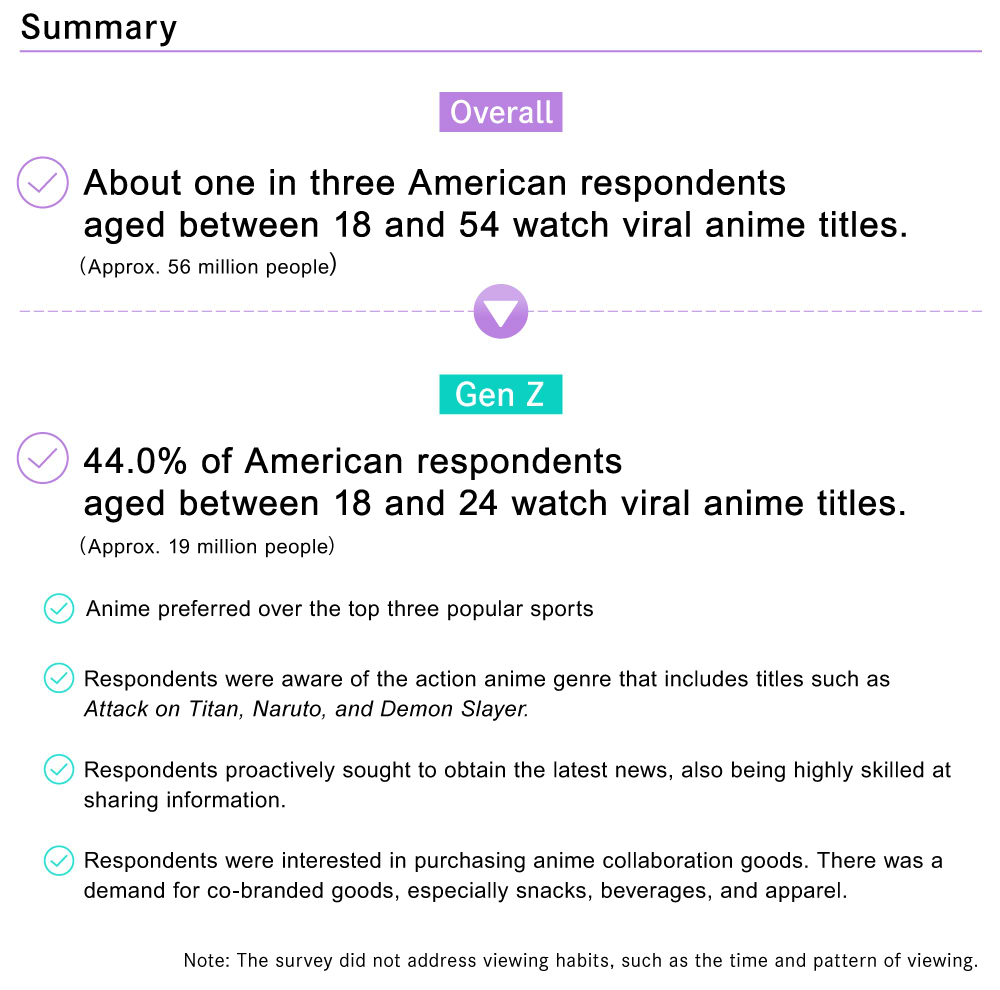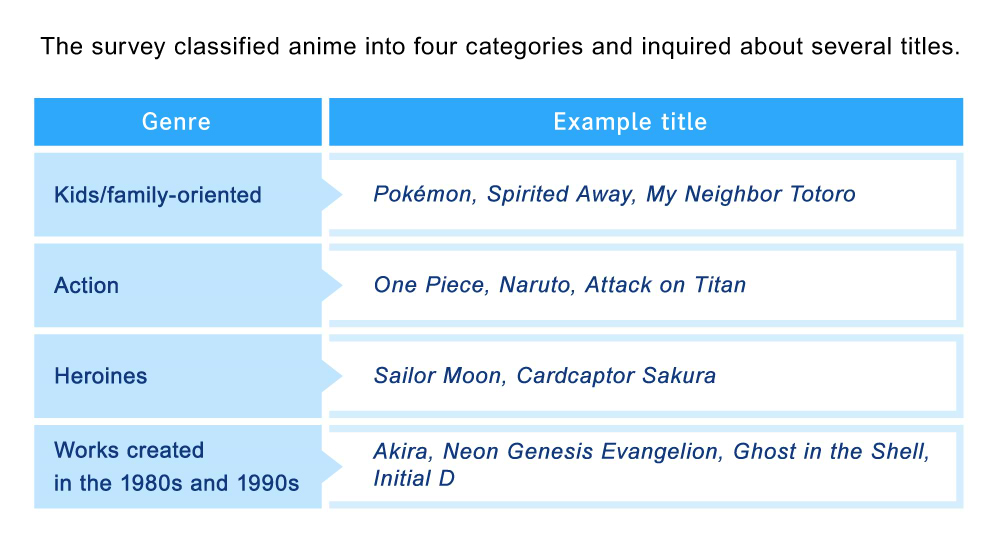Japanese anime is all the rage! Although you may already be aware of this, anime has now advanced to the next phase in terms of popularity. As an industry, it has seen an astounding rate of growth, with the market’s size doubling over just the past ten years.
The widespread expansion of video streaming platforms lies behind this growth. Nowadays, Japanese-born anime series are broadcast to people around the world in real-time. Anime’s popularity has further been spurred by the explosive increase in video viewing times during the COVID-19 pandemic.
It is no exaggeration to say that especially for Gen Z digital natives, anime is now part of the mainstream culture, rather than a niche hobby only known to a few dedicated enthusiasts.
This series of articles discuss the growing global popularity of anime, presenting results from Dentsu Inc.'s independent survey conducted in the US. In Part 1, Eimi Shimizu, an employee at Dentsu Inc.’s Content Business Design Center who has lived in the US for an extensive period, reports on the latest developments surrounding the anime industry, both in the US and throughout the world.
In addition to anime, manga is also rapidly gaining popularity in the US. A major change can be seen in Gen Z!
The anime industry has recently been growing at a high rate, reaching a market size of 2,742.2 billion JPY in 2021. It is now truly a massive industry by any measure.
Dentsu conducted a survey in July 2022 on the topics of the popularity of anime in the US and the characteristics of anime consumption especially in Gen Z, targeting Americans aged 18 to 54. (For the survey overview, please refer to the end of the article.)
Let’s take a look at some of the findings.

What do you think? Despite the fact that this survey did not specifically target anime fans, 44% of American Gen Z respondents watched anime!
Additionally, over 40% of them had friends with whom they talked about anime, or had read the original manga comics which anime titles were based on. This clearly differs from past trends, demonstrating the formation of something resembling a “Japanese subculture ecosystem” within this section of American society.

What is especially notable is the high percentage of respondents who have read the original manga comics which anime series are based on.
In Japan, a “manga superpower,” manga comes first. In contrast, in countries other than Japan, viewers’ first point of contact with various works often comes in the form of anime rather than manga. In most cases, only one part of a manga series is animated at a time, leading viewers who watch the anime to then turn to the corresponding original manga to find out how the story develops.
Thus, with the popularization of video streaming services, the sales of Japanese manga have also greatly increased throughout the US and other countries. In light of the aforementioned survey results, we can surmise that Gen Z is at the center of this trend.
Having lived in the US for many years, I recently noticed that manga sections have become a staple at many bookstores around the country.

In this survey, when asked if they were anime otaku*, as many as 34% of Gen Z respondents answered in the affirmative. In other words, an astounding 34% of America’s Gen Z, or around 15 million people, acknowledge themselves as anime otaku. Amazing, isn’t it?
Nowadays, Japanese anime and manga are not something enjoyed only by a small, dedicated fanbase. As you can see, there has been a significant paradigm shift over the past several years.
| * | Otaku: a person (usually young) obsessed with a certain hobby or subculture |
|---|
Non-Japanese anime fans already play a major role in supporting the anime market!
Now, let's set the US aside for a moment and take a look at the rest of the world.
As expected, Japan has historically represented a large portion of the market for anime. However, with the growth of video streaming services, other countries’ market share began a rapid expansion from around 2015, ultimately overtaking that of Japan in 2020.
Although the scale of the anime industry shrank temporarily due to the COVID-19 pandemic in 2020, it reached a record high of 2,742.2 billion JPY in 2021, a figure around twice that of ten years ago – a rare example of a true “growth industry.”
Although there are many different factors underlying these changes, the market’s current configuration is largely attributable to the popularization of video on demand (VOD) streaming platforms. Services including Netflix, Amazon Prime, Disney+, and others have begun providing a variety of high-quality anime titles around the world.
As people were largely confined to their homes throughout the pandemic, many picked up the habit of streaming videos online. Nowadays, just about everyone enjoys video content on their smartphones or TVs. To meet sharply rising demand, streaming service providers have started to concentrate on offering varied high-quality content from a multitude of countries.

Japanese anime was one of the types of content that they focused on. Today, as soon as an anime title is produced in Japan, it is broadcast globally at nearly the same time, although this is not necessarily the case for all titles.
Thanks to this lagless broadcasting, anime fans throughout the world can enjoy the best moments from a series in unison. Some anime production companies have taken notice of this and have begun providing information about their works to fans around the world in English as well as Japanese using their official accounts on X (formerly Twitter) and YouTube. Certain official YouTube channels’ promotional videos have actually attracted more viewers outside of Japan than within Japan.
As an aside, as video streaming services have begun to overtake regular broadcasting, new services for measuring the popularity of video content using different and unconventional indices have begun popping up. An example of one such service is Parrot Analytics, a research firm which predicts the popularity of various series, including dramas.
Parrot Analytics rates the popularity of video content and ranks series by analyzing multiple factors, including the amount of social media mentions and engagement rates. In 2021, the Japanese anime series Attack on Titan came in at first place despite fierce competition from many popular dramas.
In the past, many Japanese anime titles were neither translated nor distributed to anime fans outside of Japan. But nowadays, an overwhelming number of series have become available around the world. Additionally, the number of available genres has also increased, which has enabled people with no prior contact with anime to discover and enjoy the medium, resulting in an increased total number of viewers.
Which types of entertainment does Gen Z enjoy in the US? Sports? Dramas? Or anime?
Next, I would like to introduce a few survey results which help clarify the positioning of anime among numerous other types of entertainment content.
Anime was compared with the following content: movies, music, games, TV dramas, influencers (e.g., YouTubers), and sports (MLB, NFL, NBA).
To maximize the accuracy of trend analysis, anime titles were classified into four categories: Kids /family-oriented; Action; Heroines; and Works created in the 1980s and 1990s. Please note that this classification is just for convenience.

The most remarkable finding was the difference in the positioning of anime and sports when comparing the average of all the generations with that of just Gen Z.
The following chart shows the rates of respondents saying they like each category of entertainment (multiple answers allowed). First, let’s take a look at the average of all generations.

The NFL, part of the Sports category, ranked higher in terms of enjoyment than Anime.
Gen Z was asked the same question. The rate of enjoyment of anime surpassed that of the top three most popular sports in America, including the NFL, which ranked higher in the above chart.

When I was a college student in the US during the early 2000s, anime and manga were a niche market enjoyed by a small number of enthusiastic fans. Never did I imagine that one day anime would have more fans than major sports leagues such as the NFL, MLB, and NBA.
But nowadays, Gen Z celebrities, artists, athletes, and influencers frequently express their admiration for anime online and on social media.
Shohei Ohtani, a popular Japanese baseball player currently in his 20s, reportedly recommended some titles to his teammates who were also fans of anime and manga. Megan Thee Stallion, a 28-year-old American rapper (as of Sept, 2023) with two singles in the yearly Billboard Top 100, has revealed that she is a big fan of several anime titles including My Hero Academia.
Nowadays, it is not uncommon for star NFL players and pop singers with scores of teenage fans to regularly post about anime on social media, stirring up a buzz. I believe this shows just how much the times have changed.
Various collaborations between anime and companies in different industries have been popping up
Finally, let's examine corporate promotional activities that utilize anime.
Various companies have devised tie-in campaigns with manga and anime content. The trend in recent years has been to try to appeal to younger audiences, including Gen Z.
Even popular long-standing business enterprises have had difficulty drawing the attention of young people around the world. Currently, among members of Gen Z throughout the world, a variety of anime has gained popularity, so you could say it is only natural it would attract the attention of businesses looking to create tie-in campaigns.
For example, Pizza Hut Taiwan has developed a new pizza in collaboration with the anime series Attack on Titan. There are many other examples of special projects and unique anime tie-in products and campaigns around the world.

In the survey, America’s Gen Z was asked about their intention to buy products co-branded with entertainment content. They showed a strong intention to buy snacks, beverages, electronic equipment, and apparel created in collaboration with anime titles.
An important fact to understand is that although one may think a company should collaborate with the most popular anime series which is on everyone’s mind, regardless of context, the key to the success of a tie-in campaign actually lies in choosing a series consistent with the world view and context of the company or brand.
Although anime is a single type of entertainment, each series has its own unique fandom. If there is even a slight mismatch between a company and the anime series it is cobranding with, fans will notice this and react negatively.
On the other hand, if a campaign manages to create a positive synergy between a company and an anime series, fans will readily act as influencers in promoting it. They will generate a viral effect, for example by actively posting about the collaboration on social media.
From the next publication onward, I will be doing a deep dive into various insights from anime fans around the world by introducing case studies of anime-related marketing solutions by overseas companies, as well as My Anime List, the largest anime community in the English-speaking world!
| [Survey Overview] | |
|---|---|
| Survey name: | Awareness survey on Japanese anime in the US |
| Survey consigned to: | DENTSU MACROMILL INSIGHT, INC. |
| Survey method: | Internet-based survey |
| Survey subjects: | Americans aged between 18 and 54 |
| Sample size: | Approx. 600 people sampled from a general group of different ages, a Gen Z-only group, and an anime fan-only group, respectively |
| Responses: | Approx. 1,800 people |
| Survey period: | August 5 - 17, 2022 |
Related Link
The Numbers Speak for Themselves! Anime is Killer Content for Gen Z (Japanese language only)
